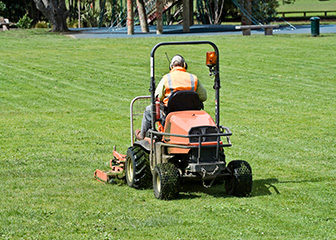
Grounds maintenance workers mow, edge, and fertilize lawns.
Grounds maintenance workers install and maintain landscapes, prune trees or shrubs, and do other tasks to ensure that vegetation is attractive, orderly, and safe.
Duties
Grounds maintenance workers typically do the following:
- Mow, edge, and fertilize lawns
- Weed and mulch landscape beds
- Trim hedges, shrubs, and small trees
- Remove dead, damaged, or unwanted trees or branches
- Plant flowers, trees, shrubs, and other plants
- Apply pesticides, herbicides, or other treatments to plants or soil
- Water lawns, landscapes, and gardens
- Monitor and maintain plant health
Grounds maintenance workers do a variety of tasks to achieve pleasant and functional environments. They care for outdoor grounds of businesses, homes, parks, and other spaces and for indoor plants in hotels, malls, botanical gardens, and other commercial and public facilities. They generally work under the direction of a landscaping, lawn service, or groundskeeping supervisor.
Depending on their specific tasks, grounds maintenance workers may use a variety of handheld tools (such as such as garden shears, spray applicators, and shovels) and power equipment (including lawnmowers, chain saws, and backhoes).
The following are examples of types of grounds maintenance workers:
Landscaping workers plant flowers, shrubs, trees, and other vegetation to create new outdoor spaces or to upgrade existing ones. They also trim, fertilize, mulch, and water plants. Some grade and install lawns or construct hardscapes such as walkways, patios, and decks. Others help install lighting or sprinkler systems. Landscaping workers attend to a variety of commercial and residential settings, such as apartment buildings, homes, hotels and motels, office buildings, and shopping malls.
Groundskeeping workers, also called groundskeepers, focus on property upkeep. Their duties include maintaining plants and trees, raking and mulching leaves, and laying sod. They also care for ornamental features, such as fountains, planters, and benches; clear snow and debris from walkways and parking lots; and tend to groundskeeping equipment. They work on many of the same settings that landscaping workers do, as well as on athletic fields, cemeteries, and other lands that need maintenance.
Groundskeeping workers who care for athletic fields keep natural and artificial turf in top condition, mark boundaries, and may paint turf with team logos and names before events. They regularly mow, water, fertilize, and aerate natural fields and ensure that the underlying soil drains properly. They also vacuum and disinfect artificial turf to prevent growth of harmful bacteria and replace worn turf or cushioning periodically.
In parks and recreation facilities, groundskeepers care for lawns, trees, and shrubs. They also maintain playgrounds; clean buildings and inspect, repair, and paint them as needed; and keep parking lots, picnic areas, and other spaces free of litter. They may erect and dismantle snow fences and maintain swimming pools.
Some groundskeepers specialize in caring for cemeteries and memorial gardens. They dig graves to specified depths. They mow grass regularly, apply fertilizers and other chemicals, prune shrubs and trees, plant flowers, and remove debris from graves.
Greenskeepers maintain golf courses. Although similar overall to that of groundskeepers, their work on turf maintenance may be more complex. They also periodically relocate holes on putting greens and maintain canopies, benches, and tee markers along the course.
Pesticide handlers, sprayers, and applicators apply herbicides, fungicides, and insecticides to plants or soil to prevent or control weeds, insects, and diseases. They inspect lawns for problems and apply chemical or other treatments to stimulate growth and prevent or control threats to cultivated plants.
Tree trimmers and pruners, also called arborists, cut away dead or excess branches from trees or shrubs to clear utility lines, roads, sidewalks, and other areas. Some specialize in diagnosing and treating tree diseases. Others specialize in pruning, trimming, and shaping ornamental trees and shrubs.
 United States Department of Labor
United States Department of Labor









